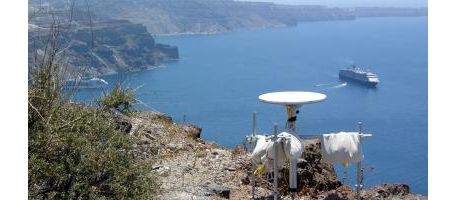The volcanic Greek island of Santorini – named by the BBC as the world’s best island last year – appears to be working up to an eruption, its first for over 60 years.

The caldera is awake again, and rapidly deforming at levels never seen before, says Georgia Tech associate professor Andrew Newman, who set up more than 20 GPS stations on the island in 2006.
“After decades of little activity, a series of earthquakes and deformation began within the Santorini caldera in January of 2011,” he says.
“Since then, our instruments on the northern part of the island have moved laterally between five and nine centimeters. The volcano’s magma chamber is filling, and we are keeping a close eye on its activity.”
The changes may not indicate an imminent eruption – other, similar calderas around the globe have shown similar activity without erupting. However, Newman says the chamber has expanded by 14 million cubic meters since last January – meaning that enough magma has been pumped into the chamber to fill a sphere three football fields across.
Any eruption, says Newman, could be worse than anything the island has seen in the last 450 years.
“That could be dangerous,” he says. “If the caldera erupts underwater, it could cause local tsunamis and affect boat traffic, including cruise ships, in the caldera. Earthquakes could damage homes and produce landslides along the cliffs.”
Santorini is the site of one of the largest volcanic events in human history: the Minoan eruption, which occurred around 1650 BC. This buried the major port city of Akrotiri under more than 20 meters of ash, and created the island’s famous, present-day cliffs.
Newman says the next eruption is unlikely to be anything like as serious: the current inflation in the magma chamber is less than one percent of that which preceded the Minoan blast.






